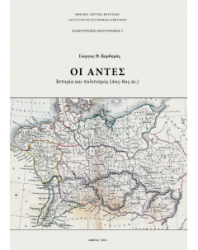Title:
The Antes. History and Culture (4th-8th c. A.D.)
Abstract:
The monograph aims to offer a global perspective on the history and culture of the Antes, a people of Slavic origin with a relatively brief historical presence in the turbulent era of Late Antiquity and the Early Middle Ages. The work has the
following structure:
Introduction: Research data and historiographic approaches.
First chapter: The Venethi question and the Early Slavs.
Second chapter: Early history and ethnography of the Antes.
Third chapter: The Antes and Byzantium.
The monograph aims to offer a global perspective on the history and culture of the Antes, a people of Slavic origin with a relatively brief historical presence in the turbulent era of Late Antiquity and the Early Middle Ages. The work has the following structure:
Introduction: Research data and historiographic approaches.
First chapter: The Venethi question and the Early Slavs.
Second chapter: Early history and ethnography of the Antes.
Third chapter: The Antes and Byzantium.
Fourth Chapter: The Penkovka culture.
The work is completed by the Conclusions, Appendix (namely the references to the title Anticus), an English Summary, Abbreviations, Literature, Index and List of Figures.
The study, based on the research outcome both in the West and Eastern Europe, do not aim to make widely known an early Slavic people quoting only the current research data. Main target is the promotion of various aspects of the Antic history and culture and to highlight further a number of issues which are crucial for understanding the historical context and the relations that the Antes developed with their surroundings. Such issues are the connection of the Antes (widely the early Slavs) with the ancient people of Venethi, the extent of the Antic settlement and the peculiarities of their internal organization, taking into account the data of other disciplines as the Archaeology and the Ethnology. Moreover, the relations of the Antes with Byzantium are examined too in relation to the protection and reorganization of the Lower Danube frontier in the era of Justinian and, on the other hand, is critically interpreted the meaning of the title Anticus to the Byzantine emperors from 533 to 612. Issues that are also put in scrutiny is the presence of the Antes in the Byzantine army, with main point of reference the general Chilvudius, while a new approach on the extent of the early Slavic settlements, taking into account the instructions of Maurice’s Strategikon for the tactical movements against the early Slavs, is attempted. Finally, regarding the cultural aspect, apart from the overall treatment of the Penkovka culture and the possible external influences on it, the cultural contacts of the Antes with Byzantium as well as the research data on the so-called ‘‘Antic antiquities’’ and certain finds in Greece connected to the Antes, are promoted.
In the monograph is drawn the conclusion that the Antes were a Slavic people, related to the Sclaveni, and both peoples formed the two branches of the Early Slavs. Compared to the Sclaveni, the Antes accepted more influences from the Germanic or steppe peoples, as arises from their political organization and their material culture (the metallourgy of the Penkovka was more developed than the Korčak-Prague or Koločin culture). The model of the centralized power to the Antes is appeared only in the 4th century. For the 6th century, the data indicates that the archontes of the Antes (leaders of tribal unions which still had a not developed social hierarchy) held an intermediate position between a monarch and a chieftain, while in the case of the Sclaveni are rather evident only the chieftains. The fact that these leaders were not simple tribal chiefs is confirmed by the genealogy of certain Antes and, from the archaeological point of view, by the Martynovka type treasures and the possible role of Pastyrsk’e fortress as an administrative center.









